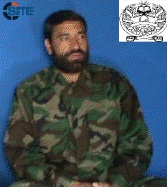|
|
|
Muhammad Wali, who allegedly shot and killed seven US soldiers on July 4 in Wardak province. |
In two communiques posted on its website over the weekend, the Afghan Taliban highlighted recent killings of Coalition troops by Taliban in the uniform of Afghan security personnel. According to the SITE Intelligence Group, which translated the statements, a Twitter posting by another Taliban spokesman provided further detail on the attacks. These three Taliban statements all refer to actual attacks but contain exaggerations as to casualty counts.
On Sept. 15, Taliban spokesman Yusuf Ahmadi claimed that an Afghan soldier named Gul Agha opened fire on “occupying soldiers” at a military base in Babaji district in Helmand province, killing six soldiers before being killed by return fire. According to the statement, the attacker “work[ed] in the occupier’s base in the area of Maljir in Naqilo.”
On Sept. 16, Taliban spokesman Imran Khalil claimed that an Afghan soldier opened fire on a group of US soldiers in the Mizana district of Zabul province, killing four US soldiers and severely wounding others, as well as killing “a number of agent policemen.” Khalil also reiterated the Taliban claim to killing six soldiers in the Babaji district, and noted that “[the insider] attacks came only one day after 15 mujahideen of the Islamic Emirate stormed one of the largest and most well-guarded bases [Camp Bastion] ….”
|
|
|
Hikmatullah, who allegedly shot and killed six Australian troops on Aug. 30 in Uruzgan province. |
And also on Sept. 16, a Taliban representative claimed in a Twitter posting that the Zabul attack had been carried out with the aid of seven Afghan policemen who were retaliating for the film “Innocence of Muslims.” The representative included pictures of two Afghan soldiers who had fired on Coalition troops in previous incidents: Hikmatullah, who allegedly shot and killed six Australian troops on Aug. 30 in Uruzgan province and then fled to the Taliban, and Muhammad Wali, who allegedly shot and killed seven US soldiers on July 4 in Wardak province.
Like most Taliban statements, these latest ones contain a propagandized mixture of fact and fiction.
The Sept. 16 attack in Zabul province resulted in the deaths of four USAF troops and the wounding of several more. The attacker, an Afghan policeman, was killed in return fire from another soldier; several other Afghan policemen were wounded.
The Sept. 15 attack in Helmand province resulted in the deaths of two British soldiers and the wounding of four more. The attacker was killed by return fire.
The Aug. 30 attack in Uruzgan province resulted in the deaths of three Australian soldiers and the wounding of two more. It is not clear what happened to the attacker after the incident.
The July 4 attack in Maidan Wardak did not result in any Coalition casualties, but five ISAF soldiers were wounded in the attack, and the Taliban claimed that the attacker had fled to join them.
On Aug. 7, the Taliban issued a video celebrating some of the perpetrators of the insider attacks, with a segment featuring rogue ANA soldier “Ghazi” Mohammad Rozi, who shot and injured three Australian soldiers and two Afghan soldiers on Nov. 8, 2011 at patrol base Nasir in Uruzgan province [see Threat Matrix article, Observations on Taliban video ‘welcoming’ rogue ANA soldiers]. Rozi is probably the same person who “fled the scene in an army vehicle” after the November 2011 attack.
But the disturbing fact remains that Taliban exaggerations and propaganda videos are not needed to underscore the seriousness of the problem. The insider attacks are clearly a key part of Taliban strategy, and the number of such attacks has spiked this year as the NATO drawdown continues. According to the LWJ Special Report, Green-on-blue attacks in Afghanistan: the data, insider attacks have caused 15% of Coalition casualties so far this year.
After months of apparent refusal by the US military to publicly acknowledge the pervasiveness of Taliban infiltration and influence among Afghan security forces, Coalition forces have only recently begun to take stricter measures to protect troops.
Referring to the unrelenting increase in insider attacks, General Martin Dempsey, Chairman of the US Joint Chiefs of Staff, yesterday told the Armed Forces Press Service, “You can’t whitewash it. We can’t convince ourselves that we just have to work harder to get through it. Something has to change.”
Are you a dedicated reader of FDD's Long War Journal? Has our research benefitted you or your team over the years? Support our independent reporting and analysis today by considering a one-time or monthly donation. Thanks for reading! You can make a tax-deductible donation here.










2 Comments
Hopefully the people tasked or assigned to gathering all the information related to these heinous acts are able to assemble a profile or template that assists in flushing out or exposing these type of people in the immediate or not so distant future.
CBS is reporting that “most” joint operations with Afghans have been cancelled, because of security risks:
http://www.cbsnews.com/8301-18563_162-57514546/u.s-military-suspends-joint-patrols-with-afghans/